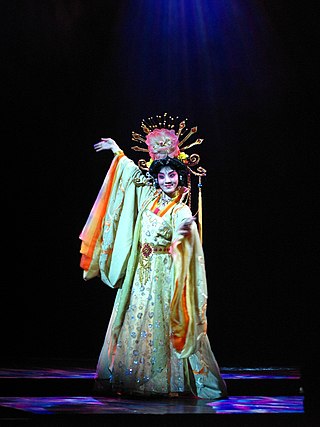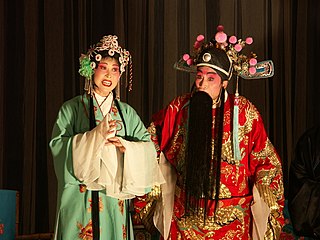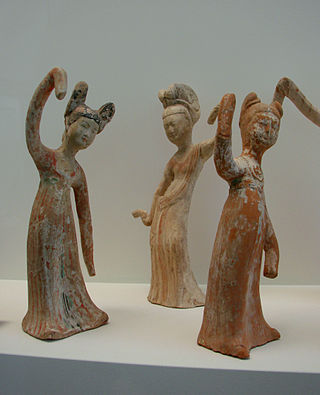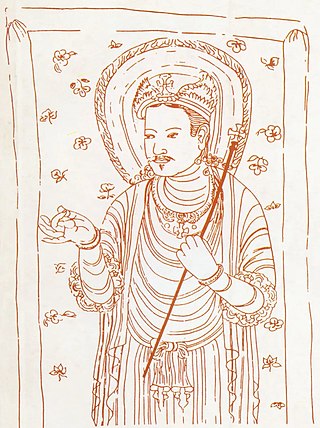
Chaozhou, alternatively Chiuchow, Chaochow or Teochew, is a city in the eastern Guangdong province of China. It borders Shantou to the south, Jieyang to the southwest, Meizhou to the northwest, the province of Fujian to the east, and the South China Sea to the southeast. It is administered as a prefecture-level city with a jurisdiction area of 3,110 km2 (1,200 sq mi) and a total population of 2,568,387. It is also the ancestral hometown of 2.7 million overseas Teochow people.

The music of China consists of many distinct traditions, often specifically originating with one of the country's various ethnic groups. It is produced within and without the country, involving either people of Chinese origin, the use of traditional Chinese instruments, Chinese music theory, or the languages of China. It includes traditional classical forms and indigenous folk music, as well as recorded popular music and forms inspired by Western culture.

Traditional Chinese opera, or Xiqu, is a form of musical theatre in China with roots going back to the early periods in China. It is an amalgamation of various art forms that existed in ancient China, and evolved gradually over more than a thousand years, reaching its mature form in the 13th century, during the Song dynasty. Early forms of Chinese theater are simple; however, over time, various art forms such as music, song and dance, martial arts, acrobatics, costume and make-up art, as well as literary art forms were incorporated to form traditional Chinese opera. Performers had to practice for many years to gain an understanding of the roles. Exaggerated features and colors made it easier for the audience to identify the roles portrayed.

Korea has produced music for thousands of years, into the modern day. After the division of Korea in 1945, both North and South Korea have produced their own styles of music.

Shaanxi History Museum, which is located to the northwest of the Giant Wild Goose Pagoda in the ancient city Xi'an, in the Shaanxi province of China, is one of the first huge state museums with modern facilities in China and one of the largest. The museum houses over 370,000 items, including murals, paintings, pottery, coins, as well as bronze, gold, and silver objects. The modern museum was built between 1983 and 2001 and its appearance recalls the architectural style of the Tang dynasty.

Qinqiang is a genre of folk Chinese opera originated in Shaanxi Province of Qing China in 1807 and soon took over other genres to be the representative genre of the province. Historically, there were two separate genres both referring themselves as Qinqiang, the one with a longer history was later renamed as Handiao Erhuang (汉调二簧), while the newer genre is the topic of this article.

Kunqu, also known as Kunju (崑劇), K'un-ch'ü, Kun opera or Kunqu Opera, is one of the oldest extant forms of Chinese opera. It evolved from a music style local to Kunshan, part of the Wu cultural area, and later came to dominate Chinese theater from the 16th to the 18th centuries. It has been listed as one of the Masterpieces of the Oral and Intangible Heritage of Humanity by UNESCO. Wei Liangfu refined the musical style of kunqu, and it gained widespread popularity when Liang Chenyu used the style in his drama Huansha ji. In 2006, it was listed on the first national intangible cultural heritage list. In 2008, it was included in the List of Representative Works of Intangible Cultural Heritage of Humanity. In December 2018, the General Office of the Ministry of Education announced that Peking University is the base for inheriting excellent traditional Chinese culture in Kunqu.

The music of Yunnan, a province in southwestern China, includes the traditional music of many ethnic groups, including the Miao, Hani and Nakhi (Naxi), the last being the most numerous in the area.

Music of Northeast China is tied closely to the region's history. Musical traditions of the Bang Zi Theatre and folk instruments such as the Dizi, Xiao, and Baijiao Gu originate in the region. Folk songs from the northeast are noted for their contributions to nationalistic music. The popular communist-era song “The East is Red” is based upon a traditional Northern Shaanxi melody. The popularity of Western musical traditions in the Harbin province is internationally recognized, with the northern city being named a ‘music city’ in 2010 by the United Nations. Contemporary folk, as well as modern pop music, continue to contribute to the diverse musical traditions of the region. Prominent performers from the Northeast include the mid-20th-century film composer Lei Zhenbang and pop stars Xiao Ke and Na Ying.

Theatre of China has a long and complex history. Traditional Chinese theatre, generally in the form of Chinese opera, is musical in nature. Chinese theatre can trace its origin back a few millennia to ancient China, but the Chinese opera started to develop in the 12th century. Western forms like the spoken drama, western-style opera, and ballet did not arrive in China until the 20th century.

Huangmei Opera or Huangmei tone is a form of Chinese opera originating from Anqing, Anhui province, as a form of rural folk song and dance. It is also referred to as Anhui Opera. It has been in existence for the last 200 years and possibly longer. Huangmei opera is one of the most famous and mainstream opera in China, and is a class of the typical Anhui opera. The original Huangmei opera was sung by women in Anqing areas when they were picking tea, and the opera was called the Picking Tea Song. In the late Qing dynasty, the songs were popular in Anhui Huaining County adjacent regions, combined with the local folk art, Anqing dialect with singing and chants, and gradually developed into a newborn's operas. The music is performed with a pitch that hits high and stays high for the duration of the song. It is unique in the sense that it does not sound like the typical rhythmic Chinese opera. In the 1960s Hong Kong counted the style as much as an opera as it was a music genre. Today it is more of a traditional performance art with efforts of revival in mainland China, Hong Kong, and Taiwan, and mostly sung in Mandarin. In 2006, Huangmei Opera was selected for the first batch of China's national intangible cultural heritage.
The Teochew people or Chaoshanese, Teo-Swa people or Chaoshan people is an ethnic group native to the historical Chaoshan region in south China who speak the Teochew language. Today, most ethnic Teochew people live throughout Chaoshan and Hong Kong, and also outside China in Southeast Asia, including in Singapore, Malaysia, Thailand, Indonesia, Cambodia, Vietnam, and the Philippines. The community can also be found in diasporas around the world, including the United States, Canada, Australia, New Zealand, and France.

Sichuan opera is a type of Chinese opera originating in China's Sichuan province around 1700. Today's Sichuan opera is a relatively recent synthesis of five historic melodic styles. Chengdu is the main home of Sichuan opera, while other influential locales include Chongqing, Guizhou, Yunnan, Hubei and Taiwan. Sichuan opera was listed among the first batch of the Chinese Ministry of Culture's "Intangible Cultural Heritage List", announced on May 20, 2006.

Dance in China is a highly varied art form, consisting of many modern and traditional dance genres. The dances cover a wide range, from folk dances to performances in opera and ballet, and may be used in public celebrations, rituals, and ceremonies. There are also 56 officially recognized ethnic groups in China, and each ethnic minority group in China also has its own folk dances. Outside of China, the best-known Chinese dances today are the dragon dance and the lion dance.

The Chinese province of Fujianhas musical traditions that can be traced back to at least the Tang dynasty. Today the music of Fujian can be heard not only in the province itself, but also in overseas communities, particularly Taiwan.
Xintianyou is a folk music style from Shaanxi province. The name literally means "rambling in the sky." The style was originally sung and developed by porters carrying goods to far off regions. One of the most famous songs in this style is "Lan Huahua" (藍花花).
Chinese contemporary classical opera is a Chinese-language musical art form drawing on western opera traditions - distinct from modern developments of traditional Chinese opera.

Dance in China has a long recorded history. Depictions of dancing in China appeared over 4,000 years ago. The early dances may be folk dances or ritual dances, some of which developed into court dances. The most important of the early dances served important ritual and ceremonial roles and are known as yayue which continued to be performed at the imperial court until the Qing dynasty. A profusion of dances in popular and court entertainment as well as folk dances have been recorded in ancient texts. The art of dance in China reached a peak during the Tang dynasty when numerous dances were recorded. Dancing as an individual art form declined in the later eras when dances become incorporated into operas and female dancing also declined when footbinding became more prevalent. In more recent times dance has enjoyed a resurgence, and it is widely performed by the public and professionals alike.

The three Persian religions, as a medieval Chinese concept, referred to a group of Iranian religions that spread to Tang China. They were recognized and protected under Tang rule, helping them to prosper in China at a time when Sassanid Iran was falling to the early Muslim conquests. The three religious movements identified by the term were Zoroastrianism, the Church of the East, and Manichaeism.
"Lan Huahua" is a folk song from northern Shaanxi in China. The song tells of a rebellious woman named Lan Huahua who, forced into an arranged marriage, chooses to break with convention and runs away with her lover. The song became highly popular in the People's Republic of China era where she was portrayed as a symbol of class struggle, and the story of the song has been retold in poems, musical dramas and television shows.














